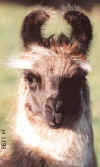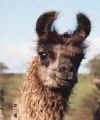|
Llama
Basics & Llama Management
Llamas are probably the easiest to maintain, most
versatile, field stock in the world
Llamas...
 | can be described as pony sized although much lighter in build, weighing circa
120-150kg. |
 | Llamas do not have hoofs but two
toes with soft pads. The toe nails may need an occasional trim
but usually wear down naturally. |
 | can be sheared annually or, more usually, every two
years. They need not be sheared, however, if you do not wish
as their coats stop growing at a manageable length. |
 | have very soft, light and warm fibre which is described as alpaca if its
thickness is measured as under 28 microns. It can usually be sold at a
good price. |
 | are intelligent and highly trainable...
|
 | are very hardy, having flourished for thousands of years in a climate where it
can be freezing before sunrise and over 100F by midday.
|
 | do not have to be exercised, nor do they need to be housed at night or in winter.
|
 | calve easily, rarely requiring human intervention.
|
 | eat less than sheep, cattle etc, on a weight ratio basis.
|
 | do not need annual dipping as with sheep. |
 | are relatively resistant to most diseases found in European livestock and
although originating from South America do not suffer from any unusual problems specific
to llamas. They have high resistance to foot-and-mouth disease and many
believe they cannot contract it naturally.
|
|

|
| A Roseland female llama
with banana ears and woolly eyebrows to die for! |
|
Fertiliser: "what goes in must come
out"
or... "where there's muck there's brass" (for
non-English Web Surfers, brass = money)
|
Back to top
|

